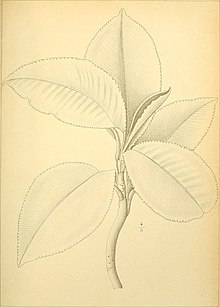Labisia is a genus of flowering plants in the family Primulaceae, native to the Malesia biogeographical region.[3] Its best known species is Labisia pumila, which is cultivated as a medicinal herb in Malaysia and Indonesia for, among other things, improving libido in women, induction of childbirth, and relieving postmenopausal discomfort.[4][5]
| Labisia | |
|---|---|

| |
| Labisia serrulata botanical illustration | |
| Scientific classification | |
| Kingdom: | Plantae |
| Clade: | Tracheophytes |
| Clade: | Angiosperms |
| Clade: | Eudicots |
| Clade: | Asterids |
| Order: | Ericales |
| Family: | Primulaceae |
| Subfamily: | Myrsinoideae |
| Genus: | Labisia Lindl.[1] |
| Species | |
|
See text | |
| Synonyms[2] | |
| |
Species
editCurrently accepted species include:
- Labisia acuta Ridl.
- Labisia alata N.E.Br.
- Labisia longistyla King & Gamble
- Labisia obtusifolia Hallier f.
- Labisia ovalifolia Ridl.
- Labisia posthumusiana Sunarno
- Labisia pumila (Blume) Fern.-Vill.
- Labisia serrulata Hallier f.
- Labisia sessilifolia Hallier f.
- Labisia smaragdina L.Linden & Rodigas
- Labisia steenisiana Sunarno
- Labisia sumatrensis Sunarno
References
edit- ^ Edwards's Bot. Reg. 31: t. 48 (1845)
- ^ "Labisia Lindl". Plants of the World Online. Board of Trustees of the Royal Botanic Gardens, Kew. 2017. Retrieved 14 July 2020.
- ^ Sunarno, B. (2005). "Revision of the Genus Labisia (Myrsinaceae)". Blumea - Biodiversity, Evolution and Biogeography of Plants. 50 (3): 579–597. doi:10.3767/000651905X622879.
- ^ Manda, Vamshi K.; Dale, Olivia R.; Awortwe, Charles; Ali, Zulfiqar; Khan, Ikhlas A.; Walker, Larry A.; Khan, Shabana I. (2014). "Evaluation of drug interaction potential of Labisia pumila (Kacip Fatimah) and its constituents". Frontiers in Pharmacology. 5: 178. doi:10.3389/fphar.2014.00178. PMC 4126480. PMID 25152732.
- ^ Fathilah, Siti Noor; Mohamed, Norazlina; Muhammad, Norliza; Mohamed, Isa Naina; Soelaiman, Ima Nirwana; Shuid, Ahmad Nazrun (2013). "Labisia pumila regulates bone-related genes expressions in postmenopausal osteoporosis model". BMC Complementary and Alternative Medicine. 13: 217. doi:10.1186/1472-6882-13-217. PMC 3847139. PMID 24007208.